Overview of an Elizabethan Outfit
by Drea Leed


This is a listing of the main elements of Elizabethan dress. (By the term "Elizabethan", I mean the dress worn by the English during Queen Elizabeth's reign, or approximately 1550-1600.
There was a very wide variation in style between 1550 and 1600--indeed, the entire sillhouette of fashion transformed itself during the 50 year timespan. The variation between the clothing worn by the nobility and that worn by the common folk was almost as great.
In addition, there is a bewildering variety in English Elizabethan womenswear. Just like today, not all women dressed in identical outfits. What a woman wore depended on her age (older women preferred more traditional styles), background (rural noblewomen weren't privy to the latest London fashions), body type (some larger women may have worn styles that flattered their figure) and individual taste. in 1580, a woman could choose to wear a French gown, round gown, loose gown, night gown, doublet, Italian gown, and Flemish and Polish gown, just for starters. Therefore, I'm narrowing it down to one lady, at one time and place.
Meet Cecily Hawkins, a minor noblewoman living in London in 1575. She's going to Elizabeth's court today, and has decided to wear her most fashionable gown: A French gown, with a low, square neckline, a tight-fitting bodice, and a full skirt gathered to the waist.
Putting on an upper-class English Elizabethan gown is a complicated process, and when you include hair and makeup, can take half an hour or more. Several writers of Elizabethan times lampooned the extraordinary amount of time required for a woman to complete her toilette and dress. Phillip Stubbes' Rant on Women's Dress, written in the 1580s, is an entertaining & informative example.
Cecily has a number of servants to do her hair and put on her shoes after she dresses. If you are unfortunate enough to lack servants to help you dress, do your hair and put on any underwear, stockings and shoes before starting. Once you're dressed, these things will be much more difficult to do. Although the Elizabethan noblewomen didn't wear underwear per se, several modern re-enactors do; when wearing elizabethan dress in hot weather, shorts can prevent chafing.
After stretching and washing her face and hands, Cecily is ready to dress. Here we go!


|
Smock/Shift
The first thing Cecily puts on is her smock, also called a shift. This innermost layer of clothing, worn by all women of all classes, was a basic undergarment worn to protect outer clothing from sweat and body oils. But which smock to wear? Cecily has different kinds of smocks; some are cut close to the body with a low, square neck and close-fitting, ungathered sleeves. Others have puffy sleeves gathered to cuffs and a body gathered to a close-fitting neckband. Since Cecily's wearing her low-cut French gown rather than a gown with a high bodice, she chooses a linen smock with a low, square neck, decorated with blackwork and narrow lace around the neck opening. Check out the Smock Page for more detailed information on smocks, including photographs and instructions on how to make them.
|

 |
Stockings
Next, Cecily opens her clothes chest and looks through her stockings. Women's hose of the 1570s came to just above the knee. Cecily has several pair of cloth hose for everyday wear. These are made of bias cut wool in a number of colors. She also has three pairs of expensive knitted hose, two of wool jarnsey yarn, and one of fine silk yarn. Today, she decides, she should wear her silk hose. Cecily's stockings are kept up by a garter, a thin ribbon tied just below the knee. The Museum of London's Clothing and Textiles book has a pattern for an extant pair of cloth stockings. as for knitted stockings, there are online instructions on how to make them at Donna Dabbler's Knitting Period Stockings page. Syke's Sutlering sells over-the-knee knitted cotton stockings for women and men in a variety of colors.
|

 |
Corset Now it's time for the corset. Cecily's corset , which she calls a "pair of bodies", is a close-fitting bodice stiffened with reed and whalebone. Cecily doesn't wear a corset every day--although she's a buxom woman, her petticoat bodies gives a fashionable enough silhouette for relaxed home wear--but for court, she needs a corset to give her the flat front line required for her French gown. Sometimes she wishes she were small-busted like her sister, Anne, who can get away with a few bones down the front of her gown bodices and rarely needs to wear a corset. For today, she slips a busk of horn down the front of her corset to make it very stiff and straight. You can find out about the history of the corset, its construction, and how to make one at The Elizabethan Corset Page. |

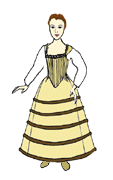 |
Spanish Farthingale Cecily's Spanish farthingale is next, which she calls a "verdingal", is a cone-shaped hoop skirt which gives the A-line shape that has become so fashionable at court in the past few years. She has some farthingales stiffened with rows of rope, which give a softer line, as well as some stiffened with willow bents, which create a very rigid shape indeed. For court, she chooses her willow-bent Spanish farthingale made of red taffeta. Her maid, Joan, slips it over her head and ties it to the corset at the sides. This keeps it from slipping down and moving, and helps transfer the weight of heavy skirts to the torso rather than having it rest all on the hips. Visit the Spanish Farthingale Page for more information on the history, development and construction of the Spanish Farthingale. |

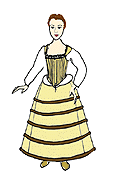 |
Bumroll Should she wear a "rowle" to Court or not? Cecily debates the question. Some women wear small, padded crescents around their hips to make skirts spring out more. The French gown Cecily plans to wear has pleats that are stuffed with batting and stiffened buckram near the top, to give them more spring, but perhaps a bumroll would give an extra "oomph" to her skirt. She decides to wear one, and Joan ties it around her waist. The article Spanish farthingales and Bumrolls talks about the evolution of this item. For information on making one of your own, check out Making an Elizabethan Bumroll. |

Petticoat
All the structural items are on, and now it's time for Cecily's creativity
to come to the fore. She has a number of different petticoats that she
can wear. Some are simple, with decorative trim around the bottom; others
are made of fancy silks. One is elaborately embroidered (a wedding gift
from her husband.)
Some are simply full skirts gathered to a narrow band, while others have
bodices sewn to the skirt and are called "petticoat bodies." Cecily feels
a chill draft creep under her hoopskirt, and belatedly wishes that she had
put on a warm, flannel petticoat under her farthingale.
A petticoat's not really suited to the French Gown she plans to wear, Cecily decides. The skirts of this kind of gown are open in front to show off a fancy forepart, which is attached to either the front of the farthingale itself, or to a fitted, a-line skirt, called a kirtle. Cecily decides to wear a kirtle instead.
This Page on Petticoats and Recipe for a Corded Petticoat have more information on the topic.

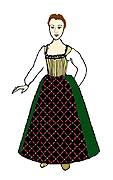 |
Kirtle and Forepart Cecily has a number of different kirtles. Many are separate skirts, although some of her "kirtles" are actually entire undergowns, worn under different styles of gowns. In fact, her "gathered kirtle", with a skirt gathered to a bodice, is indistinguishable from a "petticoat bodies." For this french gown, Cecily plans to wear a kirtle skirt over her farthingale. Her green satin kirtle fits particularly well over this farthingale, and Cecily has her maid Joan take it out of the press. After looking over her embroidered and couched foreparts, Cecily chooses one that will go well with the red velvet gown: a forepart of red taffeta and black sarcanet puffs, embroidered in gold. It has matching sleeves, like several of her other foreparts. While Joan removes Cecily's usual gold silk forepart from the green satin kirtle and stitches the new forepart on, Cecily's other chambermaid laces the matching sleeves into the armholes of her gown. Making a Gathered Kirtle and Pattern for a Gored Kirtle talk more about how to make kirtles.
|

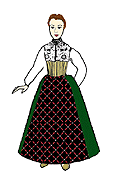 |
Partlet Cecily had planned to wear her favorite shirt under her gown. It gathers to a high neck and has poufy sleeves which gather to cuffs. It's entirely covered with blackwork embroidery. As she's wearing sleeves that match her forepart, however, the shirt isn't an option. Instead, she chooses a white silk partlet embroidered with a network design in white silk "whitework" embroidery. This partlet ties under her arms, and fills in the low neckline of her gown quite nicely. It is a "ruffed partlet", and has a large ruff attached to the neckband.
|

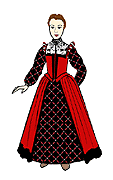 |
Gown and Sleeves At last! Time for Cecily's gown. Joan helps her into the French gown, makes sure the partlet is evenly tucked around the neckline, and laces it closed in front as the other maid, Maud, fiddles with the fashionable large shoulder rolls to make sure they're straight. Most of Cecily's gowns fasten up the front up the front, either with lacing or with hooks and eyes. The skirt is shaken out so that it lies evenly around. You can see original gowns and reproductions at the The Elizabethan Costume Page's Portraits Section.
|

 |
Shoes Cecily has several shoes to wear. They all have thin leather soles and uppers of leather, velvet or other fabrics. They are lined with wool, taffeta and satin. Some are slip-on shoes, similar to modern espadrilles. Others look rather like modern mary janes, with a low-cut top and a strap across the instep. Cecily decides to wear her red leather "latchet" shoes. These shoew have two side-flaps that fasten over a central tongue, tying with a yellow ribbon. 16th century shoe patterns, and instructions on making them, can be found at Mark Carlson's Tudor Shoe Page. |

After looking through her various headwear--a rather out-of-date french hood, a small flat cap, and several hats of differing shapes, sizes and colors--Cecily decides to wear a tall hat of white and gold brocade, embellished with several white feathers and a beautiful hatpin of enamelled gold.

Maud applies the white foundation to Cecily face and bosom, and then applies red "ceruse", or vermilion, to cecily's lips. She also puts a touch of ceruse on the cheeks.
Find out more about the makeup Cecily and other noblewomen wore in Elizabethan Makeup 101.

Ruffs
Cecily orders her fancy white linen ruff-band with the gold lace edging
and spangles to be brought from its band-box. It was set into neat, crisp
figure-eights just the night before, by a local woman known for her
starching ability and knack with setting ruffs. It has matching wrist
ruffs. Joan and maud hook them onto Cecily's neck and wrists.
More pictures and information on ruffs can be found at Constructing an Elizabethan Ruff.

Not quite satisfied with the effect, Cecily also dons a long gold chain and has Joan fix a large pendant to the front center of her bodice.

Cecily is finally ready to go to court! (And, as she steps down the stairs and out the door, is glad that she's not a courtier or lady in waiting, who has to do this every day.)
To find out more about Elizabethan costume, check out this Annotated Bibliography of Elizabethan Costume. All of the information above was derived from one of these books.